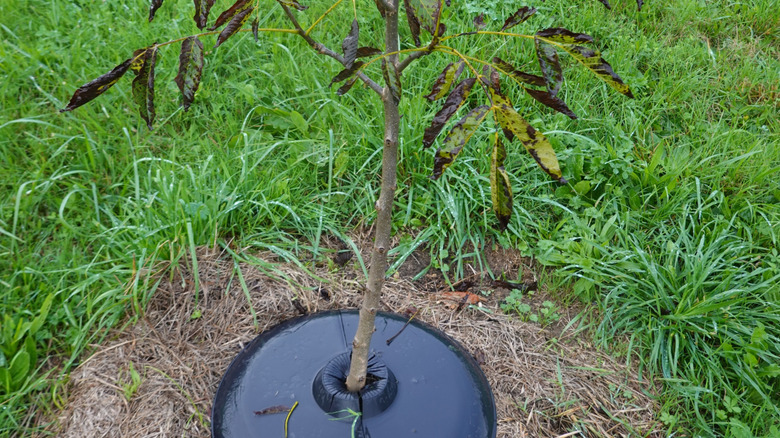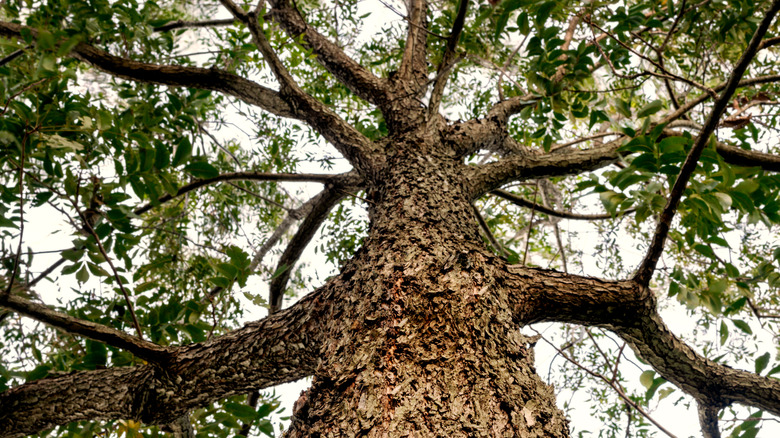The Nut Tree You Can Plant In The Fall For Lovely Spring Shade
Few things are better than reading a book in the backyard in the dappled sunlight of spring. There's a nut tree that grows to an impressive 100 feet tall and 70 feet wide at maturity, making it a perfect tree to protect you from the sun as the weather starts to warm after winter. Lovers of baked goods and trail mix are likely familiar with the delicious pecan nut, but they may not realize how useful the tree itself can be for large gardens. Carya illinoinensis, commonly known as the hardy pecan, is sometimes planted in the fall and is as useful for shade as it is for its edible bounty.
Pecans are a tough tree that is native to North America, making them a great addition to a climate-resilient garden. The pecan tree grows best in USDA Hardiness Zones 5 to 9. In the wild, it can be found in the wooded lowlands and stream banks of Iowa, Illinois, Indiana, and Ohio, growing as far south as Alabama and Mexico. It's a member of the family Juglandaceae, making it related to other nut producers like walnuts and hickory, among other trees. The massive, sweeping branches of the hardy pecan create a dense canopy in the spring and summer. However, since the tree is deciduous, it drops its leaves when the temperatures turn cold and signal the approach of winter.
How to plant a pecan tree in the fall for spring shade
Whether you want spring shade for your yard or are growing a food forest as a good alternative to your lawn, pecan trees are a great addition to your garden. For a leafy shade tree next spring, invest in a transplanted or grafted tree. A patient gardener with a long-term garden plan can cultivate a large pecan tree from a tender seedling. The latter won't grow huge in its first few years, but it will give you many years of ample shade in the future. Since they grow so large (though at a medium rate), they need plenty of space to spread out their branches and roots.
While it is generally best to plant hardy pecans in December, January, or February, they can be planted in the fall well before the first freeze, so long as they're protected from the cold during their first winter. Seeds sown in the fall will naturally stratify (get much-needed cold exposure) in the soil and germinate in the spring. Late September to mid-October planting works especially well for container-grown trees. When choosing a place for your pecan tree, opt for a location in your garden that sees at least eight hours of full sun and drains well. Remove the sapling or tree from its container, examine the root ball, and dig a hole roughly twice as wide and just as deep. Plant your tree in the hole, mulch it, and give it a healthy watering — it will be thirsty from transport.
What your fall-planted pecan needs to grow into a shade tree
Carya illinoinensis isn't commonly called hardy pecan for nothing. Pecan trees, whether planted in the fall or another season, don't need any special treatment as they grow. They thrive in most soil types and are drought hardy. They do tend to guzzle a lot of water in their first few years, so keep the roots moist but not soaked. There are a few massive mistakes to avoid when growing a pecan tree, including pruning the tree when it's too young. Beyond removing dead branches, a pecan tree should not need much pruning at all. They are prone to a number of diseases and pests; watch for signs of pecan scab, pecan aphids, and borers in particular.
The naturally vase-like canopy of a pecan tree will provide you with plenty of shade in the warmer months, but don't underestimate just how large these trees can grow. While they typically reach 70 to 100 feet tall, some trees have been known to surpass 160 feet in height. Make sure to plant a hardy pecan well over 50 feet away from structures or other large plants. If you have a modest garden in a city, this tree might not be the best fit. If you have a large yard or expansive garden, a pecan tree is a safe harbor from the sun — and provides nuts to snack on while you relax beneath its branches.


